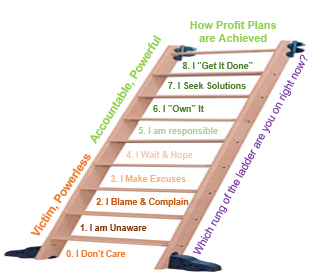
Failure to have performance conversations is one of the driving reasons why small businesses remain small. Don’t let this be the case in your business. Use the language of the accountability ladder to help you and those in your employ recognize when they and you are being accountable for the results of your actions. Even more important and powerful is to use this same tool when someone is allowing themselves to be a powerless victim.
Overview
The accountability ladder is a coaching and feedback tool used to reinforce behavior when results are better than planned and to provide coaching when behavior is interfering with realizing desired results. Effective business owners and managers use this tool to help those they lead to understand why they are or may not be getting the desired results they want out of life or their job.
The best people to work for and with are those on the upper rungs of the accountability ladder. These are the accountable people that bring power to any business.
8. Make it happen: You own it when you come up with smart solutions that you act on
7. Solutions seeker: Owning the situation starts you thinking of solutions you need to act on to hit your goal.
6. I own it: When you take ownership for the results of an action, you get to decide if you are going to fall back down the ladder and make excuses like blame and complain. Or you are going to take ownership of the problem and move forward in creating solutions that need new actions.
5. Be responsible: People at this level take responsibility for the tasks they need to do.
Nobody wants to work for or with anyone who lives their life by the lower four rungs of the accountability ladder. These are the people who are quick to consider themselves powerless victims.
4. Wait and hope: Success happens through actually going out and getting planned actions done through disciplined effort.
3. Excuse maker: Is a masked form of procrastination as to why things are not getting done. An accountable person never speaks excuses.
2. Blame and complain: Overcoming this step requires a willingness to point the finger at ourselves and admit we may be the problem, not other people or factors.
1. Unaware and noncaring: These are the people who don’t care enough to aware of any problems or their probable role in them. Building awareness and knowledge are how you help those who are blissfully ignorant.
Use this tool as part of B-CPR Step 5 when your people are struggling with accepting accountability for the results of their actions. You start using the accountability ladder by first asking yourself where you currently are on the ladder. You do this because if you’re on one of the lower rungs on the ladder, you aren’t in the best position to coach someone on how they need to move up the ladder. As you read through the different accountability rungs, you may find you are at different levels of the ladder in different aspects of your life. That’s OK; the key is to know where you are on the ladder before you try and talk with an employee about where you see them on the accountability ladder.
Once you are clear on what rung of the accountability ladder you are on, the next step is to use the same process you put yourself through to help your employees. First, you want to reinforce the behaviors you are seeing in your employees on the upper rungs of the ladder to encourage them to keep it up. Next, you want to coach those on the lower level rungs to help them see how it is holding them and the company back from accomplishing more.